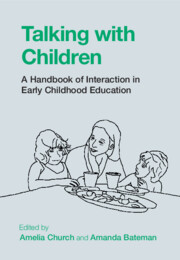Book contents
- Talking with Children
- Talking with Children
- Copyright page
- Dedication
- Contents
- Figures
- Tables
- Contributors
- Acknowledgements
- Notes on Transcription Conventions
- Introduction
- Part I Talk as Social Action
- 1 Conversation Analysis for Early Childhood Teachers
- 2 Sequences
- 3 Participation
- 4 Embodiment
- 5 Emotion
- 6 Socialization
- 7 Epistemics
- Part II Pedagogy in Interaction
- Part III Interaction and Inclusion
- Index
- References
5 - Emotion
from Part I - Talk as Social Action
Published online by Cambridge University Press: 16 June 2022
- Talking with Children
- Talking with Children
- Copyright page
- Dedication
- Contents
- Figures
- Tables
- Contributors
- Acknowledgements
- Notes on Transcription Conventions
- Introduction
- Part I Talk as Social Action
- 1 Conversation Analysis for Early Childhood Teachers
- 2 Sequences
- 3 Participation
- 4 Embodiment
- 5 Emotion
- 6 Socialization
- 7 Epistemics
- Part II Pedagogy in Interaction
- Part III Interaction and Inclusion
- Index
- References
Summary
Emotional regulation is one of the skills children develop in early childhood, and norms of social and emotional behaviour are explicitly taught and implicitly embedded in early childhood curricula. This chapter discusses emotion socialization processes in preschool settings. It outlines how various emotions (sadness, laughter, empathy, compassion and others) are displayed and interpreted in social interaction by using language and embodied resources. The chapter provides examples of how emotion socialization is configured by teachers and children in early childhood education in various countries worldwide.
- Type
- Chapter
- Information
- Talking with ChildrenA Handbook of Interaction in Early Childhood Education, pp. 97 - 119Publisher: Cambridge University PressPrint publication year: 2022
References
- 2
- Cited by

